|
Author
|
Topic: NASA logo on Vehicle Assembly Building
|
LM-12
Member Posts: 3526
From: Ontario, Canada
Registered: Oct 2010
|
 posted 12-26-2014 04:03 AM
posted 12-26-2014 04:03 AM
  
When they painted the NASA "meatball" logo on the side of the Vehicle Assembly Building back in 1998, how was it done? How do you reproduce something like the NASA meatball design on such a huge scale in such a difficult location, and do it so accurately? The worker on the lower left applies the red paint to the chevron while the worker on the right fills in the blue field to the NASA logo they are painting on the Vehicle Assembly Building (VAB). When finished, the logo, also known as the "meatball," will measure 110 feet by 132 feet, or about 12,300 square feet. Workers, suspended on platforms from the top of the 525-foot-high VAB, are using rollers and brushes to do the painting. 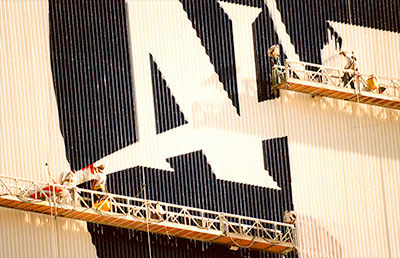 |
Jim Behling
Member Posts: 1589
From: Cape Canaveral, FL
Registered: Mar 2010
|
 posted 12-26-2014 08:22 AM
posted 12-26-2014 08:22 AM
   
This isn't a spaceflight unique task. |
p51
Member Posts: 1699
From: Olympia, WA
Registered: Sep 2011
|
 posted 12-26-2014 11:53 AM
posted 12-26-2014 11:53 AM
   
quote:
Originally posted by Jim Behling:
This isn't a spaceflight unique task.
True, painting large graphics on the sides of buildings is an ancient art form, one which was very common in cities in the 19th century and well into the 30s in the US. In most older towns, you can still see evidence to advertising slogans and company logos/names painted high on the sides of buildings in letters measured by the foot instead of point size. Anyone with an old-school commerical art education can do that, it's just a matter of how you're gonna get up to the side of the building to pull it off. |
Cozmosis22
Member Posts: 1058
From: Texas * Earth
Registered: Apr 2011
|
 posted 12-26-2014 12:01 PM
posted 12-26-2014 12:01 PM
  
quote:
Originally posted by p51:
...it's just a matter of how you're gonna get up to the side of the building to pull it off.
Reach over with a big old paint brush and do it.  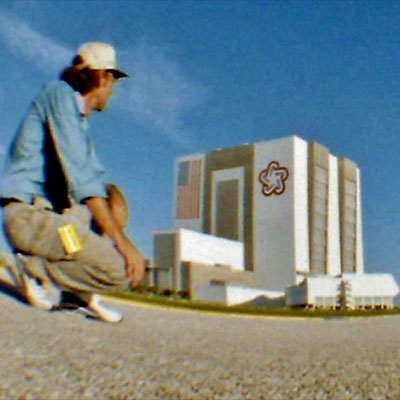 |
Robert Pearlman
Editor Posts: 45468
From: Houston, TX
Registered: Nov 1999
|
 posted 05-11-2020 12:00 AM
posted 05-11-2020 12:00 AM
   
collectSPACE 10-story-tall NASA logo being repainted for new astronaut launchesNASA is refreshing its logo for a new era a human spaceflight. The 10-story-tall insignia that adorns the side of the space agency's iconic Vehicle Assembly Building (VAB) is receiving a fresh coat of paint. The emblem's bright red vector and royal-azure blue background have faded since the Kennedy Space Center facility was last reapplied 13 years ago. 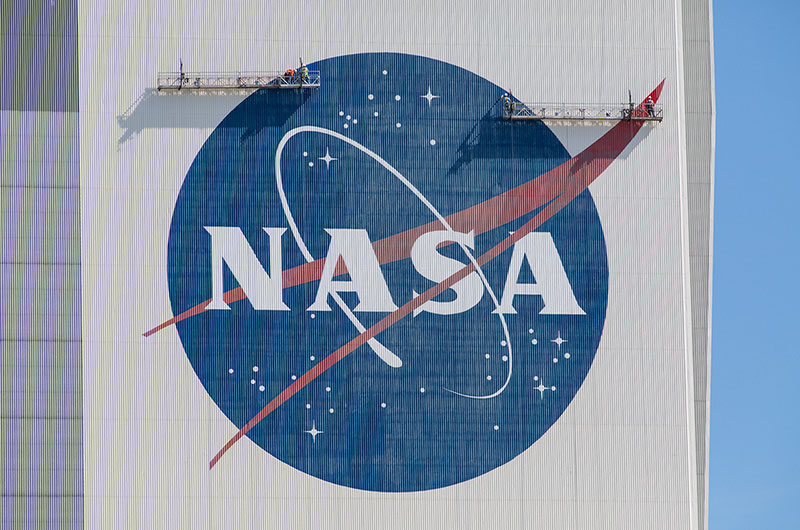 |
LM-12
Member Posts: 3526
From: Ontario, Canada
Registered: Oct 2010
|
 posted 05-11-2020 09:21 PM
posted 05-11-2020 09:21 PM
  
From the NASA "Emblems of Exploration" monograph about the meatball:
The colors of the insignia are Pantone 185 (red) and Pantone 286 (blue). |
LM-12
Member Posts: 3526
From: Ontario, Canada
Registered: Oct 2010
|
 posted 05-12-2020 02:19 PM
posted 05-12-2020 02:19 PM
  
The blue in the 1998 repaint looks darker than the blue in the 2007 repaint.
|
mf451
Member Posts: 70
From: NY, NY
Registered: Nov 2014
|
 posted 05-12-2020 02:30 PM
posted 05-12-2020 02:30 PM
   
I wonder if that has more to do with the toning on each photo. The '98 photo looks much more saturated and warm than the later photo. That would certainly change, at least in part, the colors. |
LM-12
Member Posts: 3526
From: Ontario, Canada
Registered: Oct 2010
|
 posted 05-12-2020 09:56 PM
posted 05-12-2020 09:56 PM
  
Here is the flag being repainted in 2007. |
LM-12
Member Posts: 3526
From: Ontario, Canada
Registered: Oct 2010
|
 posted 05-13-2020 09:36 AM
posted 05-13-2020 09:36 AM
  
The Bicentennial logo was on the VAB for 22 years. The NASA insignia has been on the VAB for 22 years. |
Robert Pearlman
Editor Posts: 45468
From: Houston, TX
Registered: Nov 1999
|
 posted 06-02-2020 07:28 PM
posted 06-02-2020 07:28 PM
   
Status as of May 29, 2020 (photo credit: NASA/Kim Shiflett):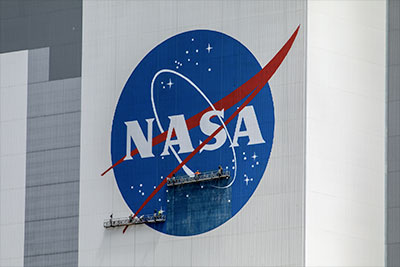 |
Robert Pearlman
Editor Posts: 45468
From: Houston, TX
Registered: Nov 1999
|
 posted 06-26-2020 03:29 PM
posted 06-26-2020 03:29 PM
   
Status as of June 23, 2020 (photo credit: NASA/Ben Smegelsky):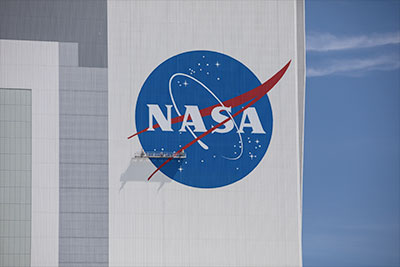 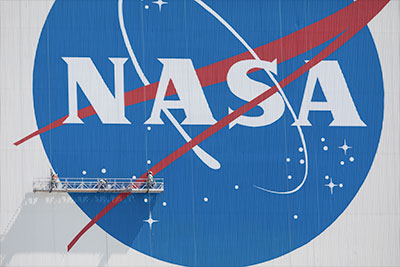
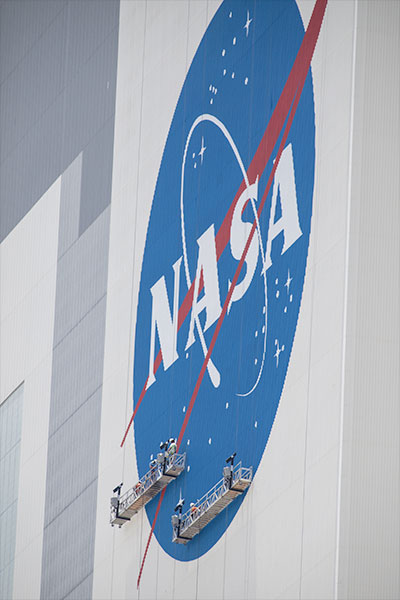
|
AstronautBrian
Member Posts: 298
From: Louisiana
Registered: Jan 2006
|
 posted 06-26-2020 03:37 PM
posted 06-26-2020 03:37 PM
   
I'd have no problem climbing into a rocket and going into space, but you'd have to pay me a lot of money to get on one of those platforms on the VAB to paint. lol |
SpaceAngel
Member Posts: 341
From: Maryland
Registered: May 2010
|
 posted 06-29-2020 01:47 PM
posted 06-29-2020 01:47 PM
   
Will the same be done with the painted American flag? |
Robert Pearlman
Editor Posts: 45468
From: Houston, TX
Registered: Nov 1999
|
 posted 06-29-2020 02:13 PM
posted 06-29-2020 02:13 PM
   
Yes, according to NASA, the flag is next. |
sev8n
Member Posts: 255
From: Dallas TX USA
Registered: Jul 2012
|
 posted 07-05-2020 10:32 AM
posted 07-05-2020 10:32 AM
  
Nice article (and pics) on the history and construction of the VAB on Ars Technica: The 160-meter-tall building was topped off in 1965 and completed in 1966. Construction photos of the VAB's development — the building required almost 90,000 metric tons of steel—are as incredible as those of the finished building itself. But NASA officials wanted to make clear at the time that this building was not an end in itself. Rather, it was a means to an end."This building is not a monument," said Kurt Debus, the German rocket scientist who supervised construction of the Florida facilities, in 1965. "It is a tool, if you will, capable of accommodating heavy launch vehicles. So if people are impressed by its bigness, they should be mindful that bigness in this case is a factor of the rocket-powered transportation systems necessary to provide the United States with a broad capability to do whatever is the national purpose in outer space." |
Robert Pearlman
Editor Posts: 45468
From: Houston, TX
Registered: Nov 1999
|
 posted 09-20-2020 04:50 PM
posted 09-20-2020 04:50 PM
   
From Kennedy Space Center (via Twitter): Painting is underway on the 209-foot-tall American flag painted on the side of the Vehicle Assembly Building. 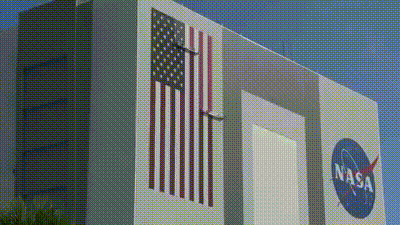 |
Robert Pearlman
Editor Posts: 45468
From: Houston, TX
Registered: Nov 1999
|
 posted 09-21-2020 04:10 PM
posted 09-21-2020 04:10 PM
   
NASA photo release A view of the 525-foot-tall Vehicle Assembly Building (VAB) at NASA's Kennedy Space Center in Florida, as painting of the U.S. flag continues on the iconic building on Sept. 17, 2020. HM2 and H.I.S. Painting of Titusville, Florida, are repainting the American Flag on the building. The flag is 209 feet long by 110 feet wide. Each star is more than six feet in diameter, and each stripe is nine feet wide. 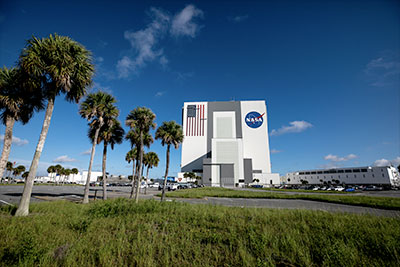 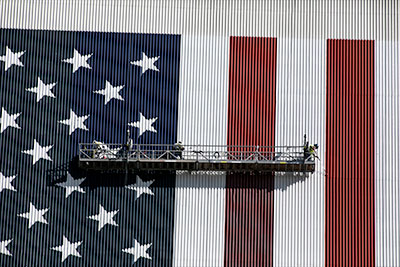
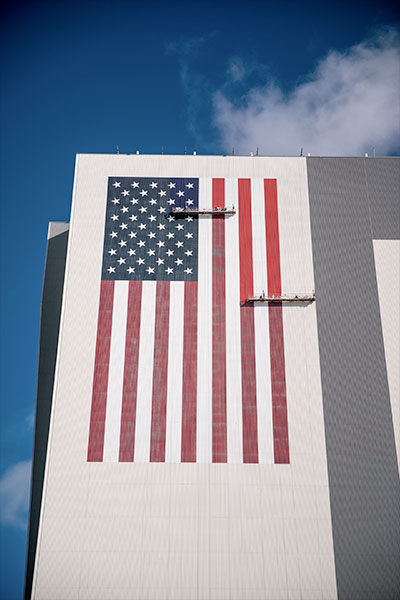
|
LM-12
Member Posts: 3526
From: Ontario, Canada
Registered: Oct 2010
|
 posted 10-29-2020 09:34 PM
posted 10-29-2020 09:34 PM
  
The flag repainting is completed.
A ground-level view of a vibrant NASA logo, referred to as the meatball, and American Flag on the Vehicle Assembly Building (VAB) at NASA's Kennedy Space Center in Florida on Oct. 27, 2020. HM2 and H.I.S. Painting of Titusville, Florida, began repainting the meatball and flag on the iconic facility in May and recently completed the project. 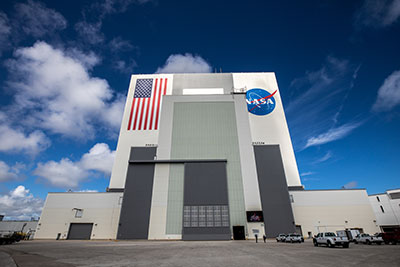 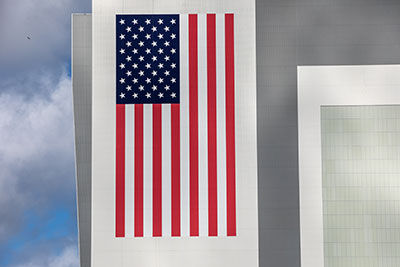
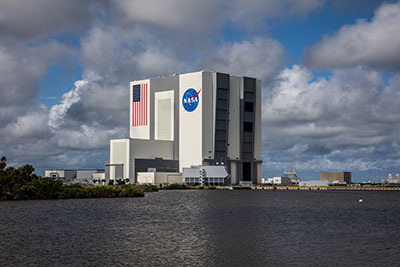
|
SpaceAngel
Member Posts: 341
From: Maryland
Registered: May 2010
|
 posted 10-30-2020 05:51 AM
posted 10-30-2020 05:51 AM
   
It's better than new! |
LM-12
Member Posts: 3526
From: Ontario, Canada
Registered: Oct 2010
|
 posted 10-30-2020 06:55 AM
posted 10-30-2020 06:55 AM
  
It looks like they repainted the gray section also. |
Robert Pearlman
Editor Posts: 45468
From: Houston, TX
Registered: Nov 1999
|
 posted 12-04-2020 03:19 PM
posted 12-04-2020 03:19 PM
   
From Florida Today reporter Rachel Joy (via Twitter): New artwork going up on the VAB just in time for the final National Space Council meeting in 2020 happening next week at KSC.  
|
SkyMan1958
Member Posts: 972
From: CA.
Registered: Jan 2011
|
 posted 12-04-2020 10:36 PM
posted 12-04-2020 10:36 PM
   
Ummmm, not to put too fine of a point on it, but isn't NASA still incapable of launching humans, and isn't the Dragon capsule stacked in the SpaceX building? Given that it's launched on an Atlas V I would assume Starliner would also be stacked in a non-NASA facility, not to mention Starliner would be owned by Boeing. I assume NASA will only be capable of launching humans once an actually crewed Orion spacecraft lifts off. I'm a strong supporter of commercial space. I'm also a proud American and am glad that the U.S. again has a human rated lift capability, but it strikes me as a waste of taxpayer dollars to paint Launch America on a NASA building when NASA can't launch Americans. |
Robert Pearlman
Editor Posts: 45468
From: Houston, TX
Registered: Nov 1999
|
 posted 12-04-2020 11:54 PM
posted 12-04-2020 11:54 PM
   
I don't think the sign is intended to imply anything about the use of the Vehicle Assembly Building itself. Rather, the VAB is the most prominent structure seen by anyone visiting Kennedy Space Center and so it is an obvious place to display such a sign, if it is the desire of the space agency to do so. "Launch America" is NASA's catchall tag (and literally, a hashtag) for its commercial crew missions. The press and invited guests who watch those missions launch do so from facilities that are adjacent to the VAB. Another new addition to the VAB has been a large Artemis banner, now hanging above the transfer aisle inside the building. 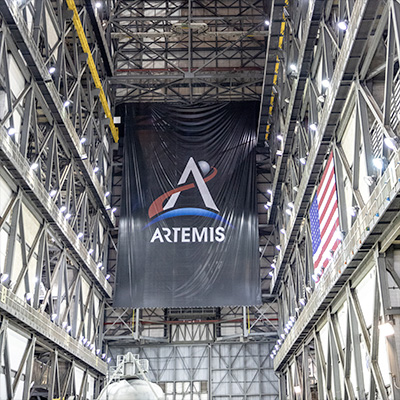 |
Robert Pearlman
Editor Posts: 45468
From: Houston, TX
Registered: Nov 1999
|
 posted 01-24-2021 01:40 PM
posted 01-24-2021 01:40 PM
   
NASA release Going Above and Beyond for a RescueWhen a broken scaffolding motor left a team of painters hanging on the side of the Vehicle Assembly Building (VAB) in October 2020, NASA Kennedy Space Center firefighter Andrew Morgan scaled down to the rescue. Now he's being recognized by the Space Coast Fire Chiefs' Association as their 2020 Firefighter of the Year. 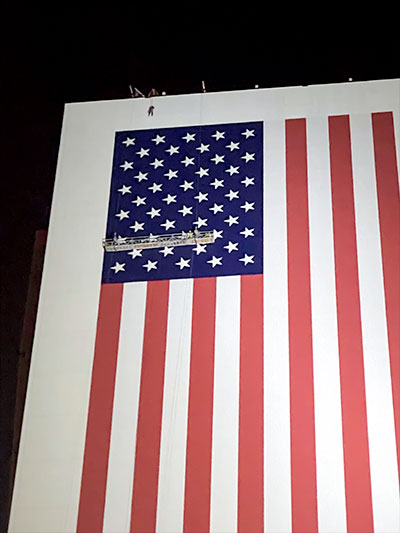 Above: NASA Kennedy Space Center firefighter Andrew Morgan rappels down the side of the Vehicle Assembly Building to rescue a team of painters when their scaffolding motor broke in October 2020, leaving them stranded 375 feet off the ground. It was this effort that led the Space Coast Fire Chiefs Association to select Morgan as the 2020 Firefighter of the Year. (NASA) "I had never been a part of a high angle rescue," Morgan said. "This was the first occasion to use the skills that my team and I have practiced many times." Morgan is a Technical Rescue Team member and part of a group that trains to rescue astronauts and closeout crew from Kennedy's launch pads during crewed launches. There are 25 volunteers who cover shifts to support the Commercial Crew Program, as well as upcoming Artemis launches. "On the Technical Rescue Team, we respond to emergency calls that require specific skills such as high angle rescue, confined space rescue, and advanced vehicle extrication," Morgan said. "I've been here 34 years, and I was on the original Technical Rescue Team," said David Seymour, assistant chief of operations, C shift. "I've never had anything like this." It was the last day of the job for the painters. Three inspectors were checking for missed spots on the giant, freshly painted American flag on the iconic VAB when the scaffolding motor on the roof broke, leaving the men and their narrow platform stuck 375 feet off the ground. They dangled 150 feet from the top, and it was a long way down. When Seymour first arrived on the scene, the paint crew feared they would have to use wire cutters to disconnect the scaffold from the motor, leaving the men to lower themselves manually to the ground. But Seymour was quick to tell them there was already a plan in place. Months earlier, when Seymour learned that the flag and the NASA meatball logo were going to be repainted, he took the Technical Rescue Team members on "C" shift up to the roof. "I told them to make a plan in case we have to go over the side and get them." The paint inspectors had already been stuck a couple of hours when Kennedy Fire Rescue got the alert. It took more time for the 19 firefighters to haul 900 pounds of rope and equipment to the roof. Reaching the top meant taking a large elevator to the 34th floor and then transferring to a much smaller elevator with a strict weight limit. "We sent up one firefighter and a weight allowance of equipment at a time," Seymour said. Once on roof, Morgan and his team set up a mechanical advantage system using pulleys and ropes, which would allow them to lower a rescuer down and haul him and a second person back up by hand. "We had to make sure that everything was precise and methodical, leaving no room for error," Morgan said. "The hardest part was the lack of visibility on the roof." Darkness had fallen, and generators with portable lighting were added to the haul of equipment. Just as the team was ready to send someone over the edge, rain began falling. Morgan volunteered to go first. Once he reached the scaffolding, Morgan strapped one of the men to his body, and the two were hauled to the roof. By that time, a replacement motor had arrived, enabling the team to lift the remaining two men to safety by the scaffold. "The rescue team did a phenomenal job. I'm proud of them," said Fire Chief Richard Anderson, Chenega Infinity. "We train for this, and NASA outfits us well." 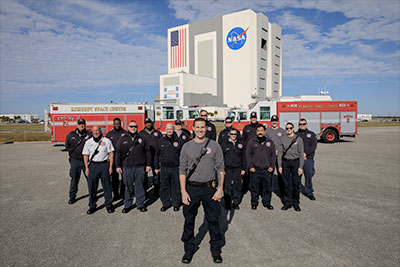 Above: NASA Kennedy Space Center firefighter Andrew Morgan, front, is selected as the Space Coast Fire Chiefs Association’s 2020 Firefighter of the Year. A member of the Technical Rescue Team, Morgan scaled down the side of the Vehicle Assembly Building to rescue a team of painters when their scaffolding motor broke in October 2020, leaving them stranded 375 feet off the ground. Standing behind Morgan are the rest of the crew on C shift at the Florida spaceport, who also assisted in the rescue mission. (NASA/Kim Shiflett) The Technical Rescue Team trains on rappelling and patient pickoffs inside of the VAB at heights of 30 to 40 feet. The shift team conducts quarterly training to review different rescue techniques and tactics, go over specialized equipment, and set up rigging and hauling systems to maintain skills and knowledge. Morgan began his firefighting career in 2007 and joined the Kennedy team in 2015. "This incident reinforced how important our training has been, and that it makes all the difference when it comes to running a true emergency call," he said. Morgan was selected as the Firefighter of the Year by the Space Coast Fire Chief's Association selection committee. He competed with other firefighters from municipalities in Brevard County, and selection was based on leadership, performance, significant self-improvement, and community involvement. "Throughout this process, Andrew has consistently recognized his fellow team members, which is a testament to him as an individual," said Chief Anderson. "It is our honor to have Andrew represent our department, our company, and NASA." |































